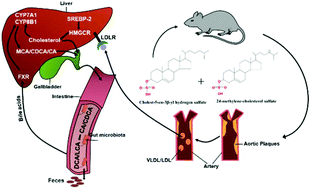Sterol sulfate alleviates atherosclerosis via mediating hepatic cholesterol metabolism in ApoE−/− mice†
Abstract
Compared with terrestrial organisms, the sterols in sea cucumber exhibit a sulfate group at the C-3 position. Our previous study demonstrated that dietary sterol sulfate was superior to phytosterol in alleviating metabolic syndrome by ameliorating inflammation and mediating cholesterol metabolism in high-fat-high-fructose diet mice, which indicated its potential anti-atherosclerosis bioactivity. In the present study, administration with sea cucumber-derived sterol sulfate (SCS) significantly decreased the cholesterol level in oleic acid/palmitic acid-treated HepG2 cells, while no significant changes were observed in the triacylglycerol level. RNA-seq analysis showed that the metabolic changes were mostly attributed to the steroid biosynthesis pathway. ApoE−/− mice were used as an atherosclerosis model to further investigate the regulation of SCS on cholesterol metabolism. The results showed that SCS supplementation dramatically reduced atherosclerotic lesions by 45% and serum low-density lipoprotein cholesterol levels by 59% compared with the model group. Dietary SCS inhibited hepatic cholesterol synthesis via downregulating SREBP-2 and HMGCR. Meanwhile, SCS administration increased cholesterol uptake via enhancing the expression of Vldlr and Ldlr. Noticeably, SCS supplementation altered bile acid profiles in the liver, serum, gallbladder and feces, which might cause the activation of FXR in the liver. These findings provided new evidence about the high bioactivity of sterols with the sulfate group on atherosclerosis.



 Please wait while we load your content...
Please wait while we load your content...